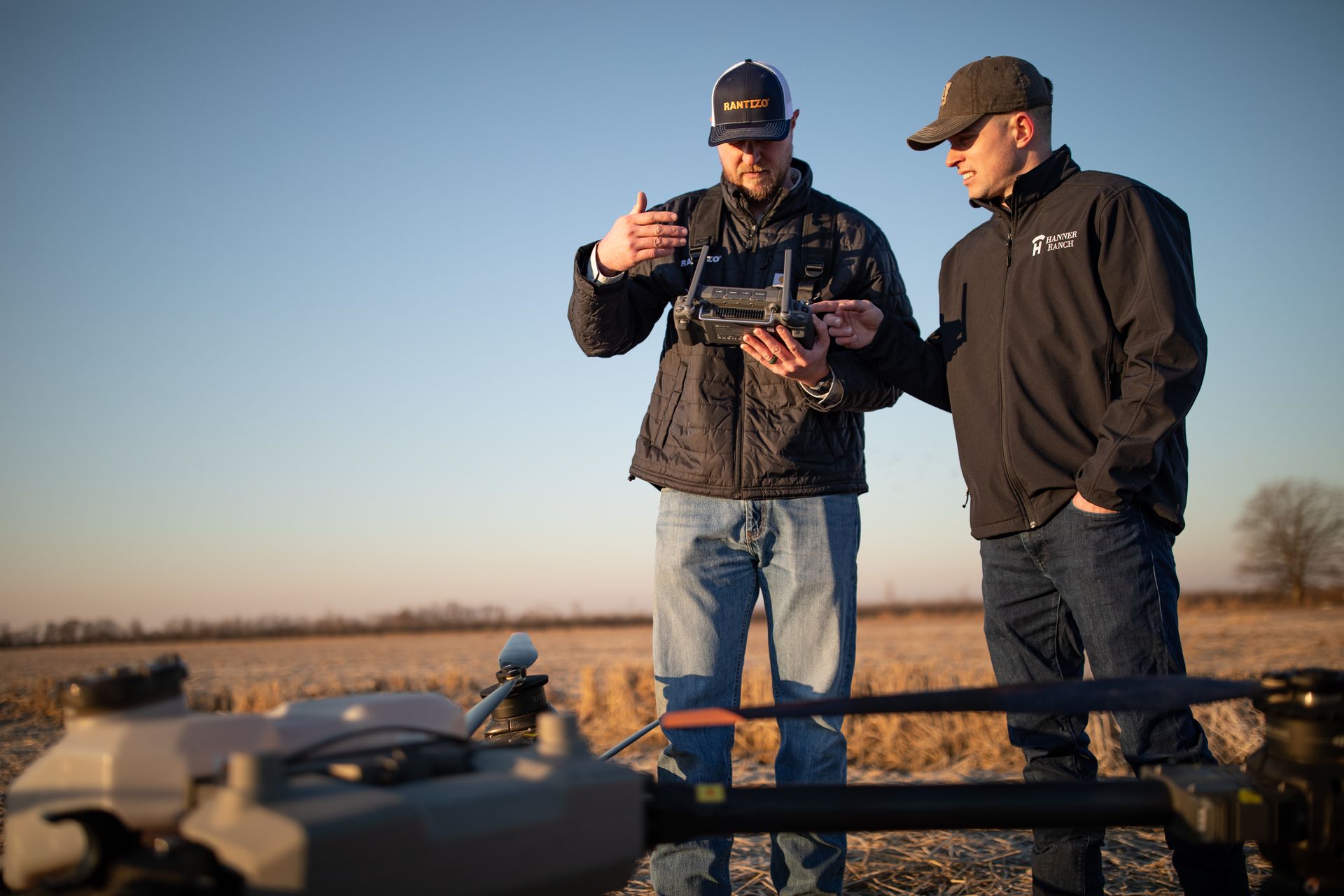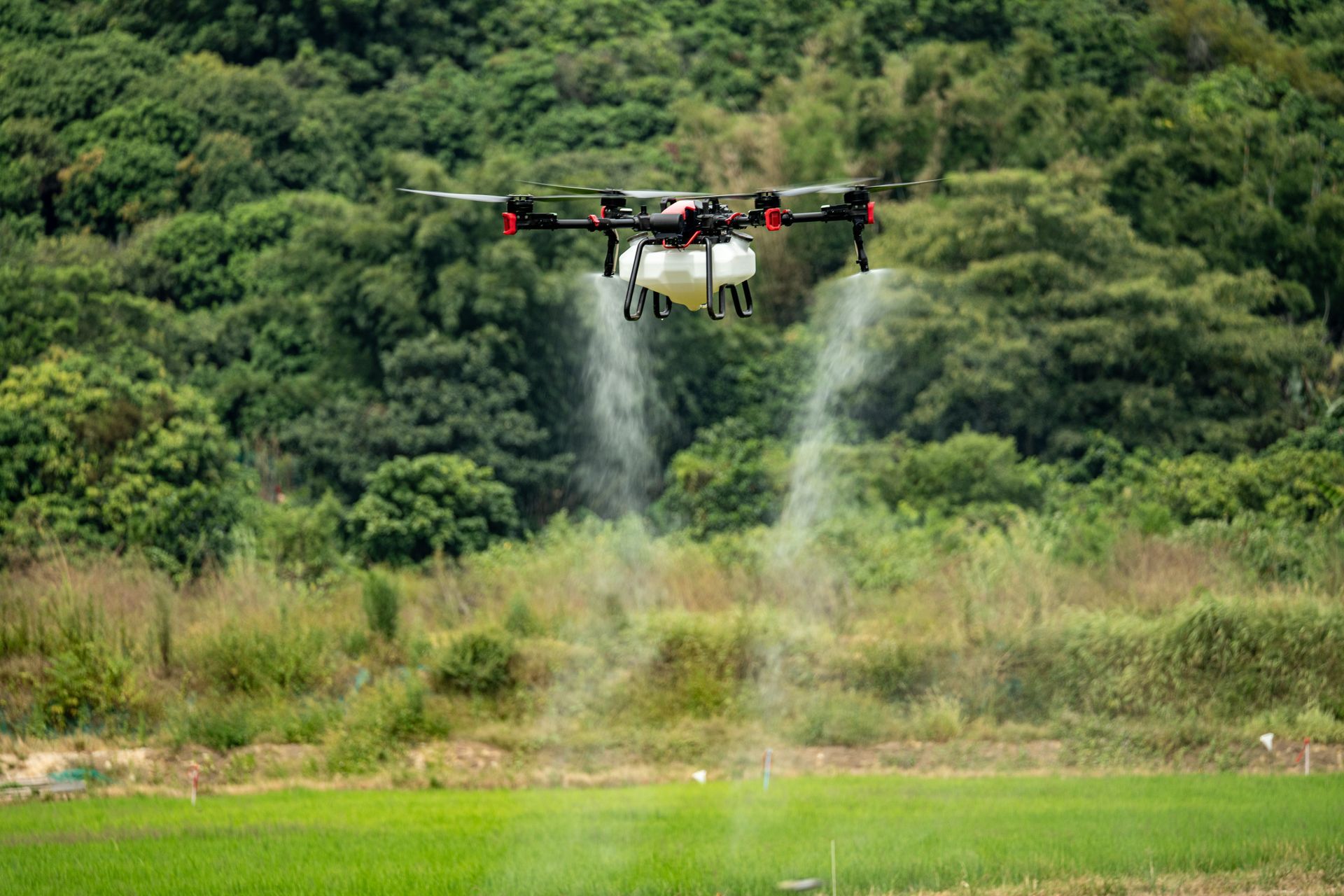Blog Layout
RESOURCES
Slaying the Fly Menace
Feb 03, 2024
Albertson Drone Combats Dairy Fly Infestations with Precision Spraying
Spraying crops can be a round-the-clock activity during the spring and summertime, but how can you fill up your time, outside of your busiest seasons, for additional revenue?
For Kyle Albertson of Albertson Drone Services, a unique opportunity figuratively fell into his lap.
“A local dairy reached out to me asking if I'd be interested in spraying around their barns and pastures to knock the heavy fly population down in summer,” Albertson says. “I gave it a try, then went back a couple weeks later to see how it was working. It worked so well that I've been going strong since.”
The dairy owner had previously tried using a crop duster and helicopter. Unfortunately, neither worked well as they needed to spray the whole farm with an animal and human-friendly spray.
After the first drone application, both Albertson and the dairy owner noticed a big difference in the intensity of the fly infestation. They settled on 2-week spray internals beginning in the spring when the weather warmed up through the end of September.
“When I first drove up to the dairy, I opened my car door and instantly about 25 flies were inside,” he laughs. “Now, after I’ve sprayed a few times, I can leave my door open and hardly see any.”
His business has expanded quickly, and he now handles 4 dairies of 18,000 cattle. Most have him spray wherever flies gather and nest, including between buildings, grassy regions, manure lagoons, standing water and over plastic-covered silage piles.
Albertson started by using a Rantizo upgrade kit on an MG-1P drone, then advanced to an Agras T10. He recently added an Agras T30 for the upcoming season.
The chemicals required depend on the farm, but he normally uses a combination of Serpent insecticide and Durant growth regulator to prevent fly eggs from hatching. Both are available from Atticus.
Albertson has a few tips he’d pass along to drone operators interested in getting into the dairy spraying niche:
- Pay close attention to the weather. Colder weather draws flies indoors, which decreases spray efficiency.
- Wait for temperatures above 65°F to get a better knock-down.
- Be aware of farm location and wind effects. Due to their higher wind conditions, Albertson’s home county, Benton County, Indiana is home to over 150 wind turbines. In an area like this, a normal altitude setting may need adjustment to deliver an accurate spray swath.
- Safe practices are key to success. Of course, people, cattle and other animals should be kept out of the spray zone, but also ask the owners about any open feed sources to avoid in the spray area that you may not have noticed.
- Be sure to establish good communication with clients making sure to inquire about any potential wildlife or pollinator habitats on the dairy. As an example, Albertson has encountered numerous farms supporting bee habitats that would have been damaged by spray pesticides.
- Initially, Albertson charged a $200 per hour fee but has since changed to a per application charge or day fee based on farm acres.
- He flies and controls his drones manually due to tight quarters around barns, buildings and other equipment, usually selecting a height of 8 to 10-ft. (dependent on wind speeds) to deliver the best spray swath.
“A lesson I learned the hard way that I emphasize for new operators spraying dairy farms is to always make sure your batteries are well charged and in good working order when spraying over manure lagoons,” Albertson laughs. “I didn't heed that advice and ended up with my drone floating in manure for about 3 hours.”
Albertson’s clients are extremely happy with how his spray drones control their dairy’s fly populations. They no longer need to worry about pesticide waste due to covering entire farmland bases with human and animal-friendly chemical from airplane applications. Drone spraying ensures accuracy and sustainability with chemicals placed exactly where they’re needed most.
To learn more about this and other use cases, register for our
upcoming webinar.
share this
past blog posts
Related blogs

09 May, 2024
The DJI AGRAS T40 drone has received several important firmware updates that enhance performance, safety, and usability. Here is a quick overview of the new and improved features and how to take advantage of these updates on your T40. PERFORMANCE UPDATES NEW! “Hills” Scene in Field Route Operation Mode A new “Hills” scene has been added to the field route operation mode to improve ground imitation accuracy for tall crops. The T40 will adjust its flight pattern when flying over hilly terrain. IMPROVED! Adjustable Route Spacing The adjustable range for route spacing has been expanded to accommodate different flight path requirements. Whether you’re covering large fields or small plots, the T40 allows you to customize the spacing. SAFETY UPDATES IMPROVED! Enhanced Propeller Motor Safety To improve safety during takeoff and landing, the propeller motors will automatically stop spinning if they remain idle for more than 10 seconds. This will prevent accidental contact with the spinning blades. USABILITY UPDATES FIXED! Abnormal Flight Altitude in Fruit Tree Operation Mode In certain situations, the T40 had abnormal flight altitude when returning to the task resume point during Fruit Tree operation mode. This issue has been fixed, giving you more accurate altitude control. NEW! Spinner Disc Disable Option The update introduces a new feature that allows you to turn off the spinner disc while maintaining other spraying functions. NEW! Cancel Auto-Landing Feature In emergencies or when adjusting landing plans, you can now cancel auto-landing by moving the control sticks. This gives you more control over the landing process. IMPROVED! Amount Spread Display The accuracy of the “Amount Spread” information displayed on the Task Summary screen has been optimized. NEXT STEPS TO TAKE ADVANTAGE OF THESE UPDATES: If you have multiple batteries: This firmware update may include* updates for the Intelligent Flight Battery. Insert each one into the drone to check if any updates are needed. Check your aircraft & controller: Ensure that both your aircraft (version 01.03.1005) and remote controller (version 04.01.1000) are updated to ensure compatibility. Incompatible versions may lead to operational issues. To learn more about these updates or request assistance, contact Rantizo® customer service at support@rantizo.com or call 319-201-3020. *Dependent on the firmware being updated from; recent versions will not need updated, older versions, most likely, will need updated.

02 May, 2024
As spray drone technology continues to evolve, operators often encounter challenges requiring expert support. From calibration uncertainties and warranty repairs to technical troubleshooting and regulatory questions, the complexities can be daunting. Whether you’re a seasoned pilot or just starting out, here’s how a support package can benefit your business. 1. Calibration Questions Calibrating your drone helps ensure correct readings for more precise spray coverage. A support team can provide peace of mind that you’ve completed the process correctly, allowing you to fly with confidence. For example, calibrating your drone helps in getting a correct report on targeted vs. actual gallons per acre sprayed following a job. Common questions asked: How do I calibrate the spray system of the drone? How often do I need to calibrate my drone? Why should I calibrate my drone? 2. Warranty Repairs If your drone malfunctions or breaks down, maintain your warranty and investment by having a Certified Technician to assist with repairs. Find a team that can help you facilitate the process and provide clear instructions to help you get back to work efficiently. Common questions asked: Why am I receiving an error message? My drone is having malfunctions that I can’t figure out. Can you help? What documents do I need to complete for warranty repairs? Why is my pump not spraying? 3. Technical Troubleshooting Technology isn’t perfect and errors do occur. Troubleshooting errors alone can be a headache. Having a drone expert you can call for help will make it easier to solve these tricky problems and get you back in the air faster. Common Questions asked: Why is my drone giving me a pump error message? Why am I getting ESC (Electronic Speed Controller) errors? Why is my charger not fast charging? Why am I getting kicked into manual flight mode? Why is my RTK not connecting? Why won’t my drone take off? 4. Regulatory Questions Starting an FAA-compliant spray drone business can be intimidating. But with the right support team, you can confidently ask any regulatory question, basic or advanced. Common questions asked: How close can I fly to an airport? What do I need if the FAA shows up and questions me? How far away from roads do I need to be? How long does my medical card last? Why did my registration get denied? 5. Basic Operation Questions Quick questions deserve a quick answer. Especially when that question could directly affect your in-field performance. When choosing a support team, ensure that you reach a real person via call, text or email who can supply that quick answer to get you back in the air. Common questions asked: How to only spray a field boundary? What is the optimal gpa to spray fungicide? What should I set my swath width at if I’m spraying a pasture? What should my chemical mixture be to spray 30 acres of wheat at 2gpa? Where should I set up my RTK? 6. In-Field Repairs Downtime is lost revenue. With a support package, you can get the support you need to get back in the air quickly. Call in with a quick repair question or troubleshoot a larger issue with a Certified Technician. They can advise on in-field repairs or schedule your drone for repairs at our shop. Common questions asked: How do I change the propellers? Why aren’t the pumps spraying at max rate? How do I change the hopper gate on the dry spreader? How do I lock the battery in? 7. Product Recommendations At times, a fresh perspective is essential. Ensure that the drone support package you choose comes with a dedicated support line, offering top-notch advice on products such as generators, nozzles, components, or personal protective equipment. Common questions asked: What is the best propeller to use? What nozzles are best for fungicide? What is the best generator for my set up? Where can I buy a mixing tank? This season, make sure you have reliable support that you can count on. For more information on support packages available from Rantizo, visit www.rantizo.com/our-services or request a quote today.
Contact US
How can we reach you?
Keep up with all the latest Rantizo news including: product releases, upcoming events, drone spraying industry tips, and more!


